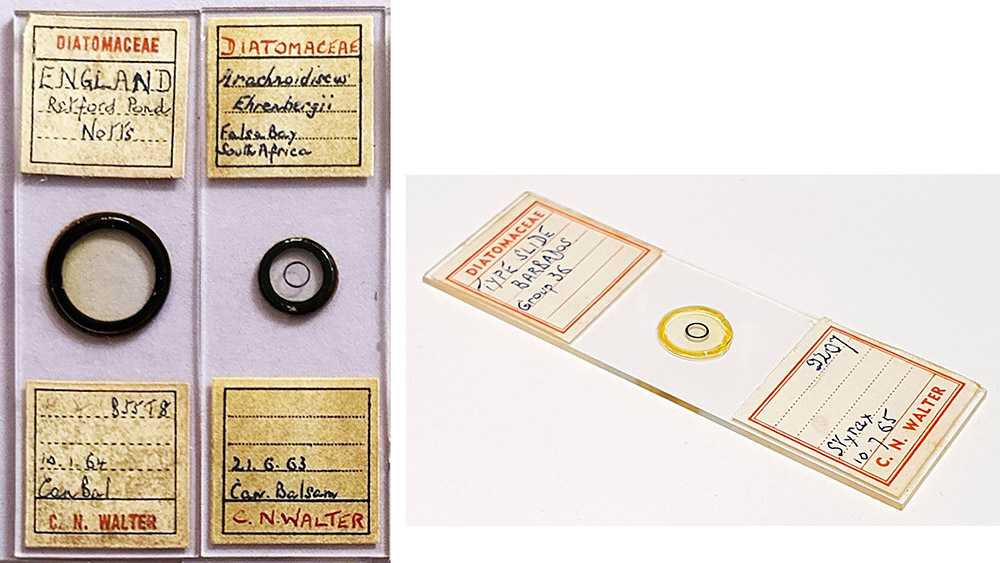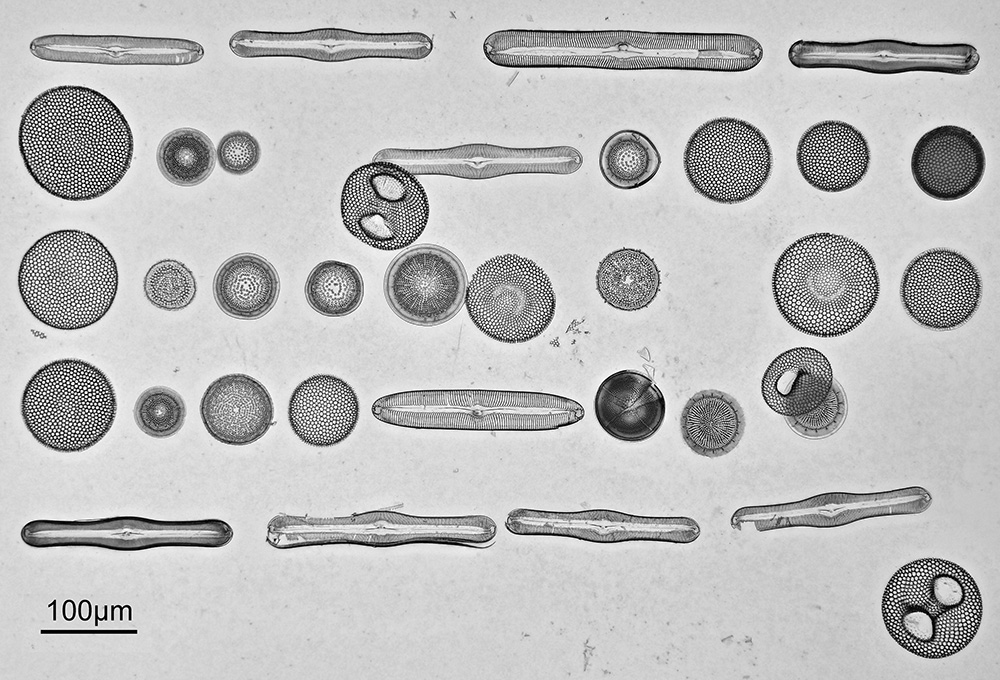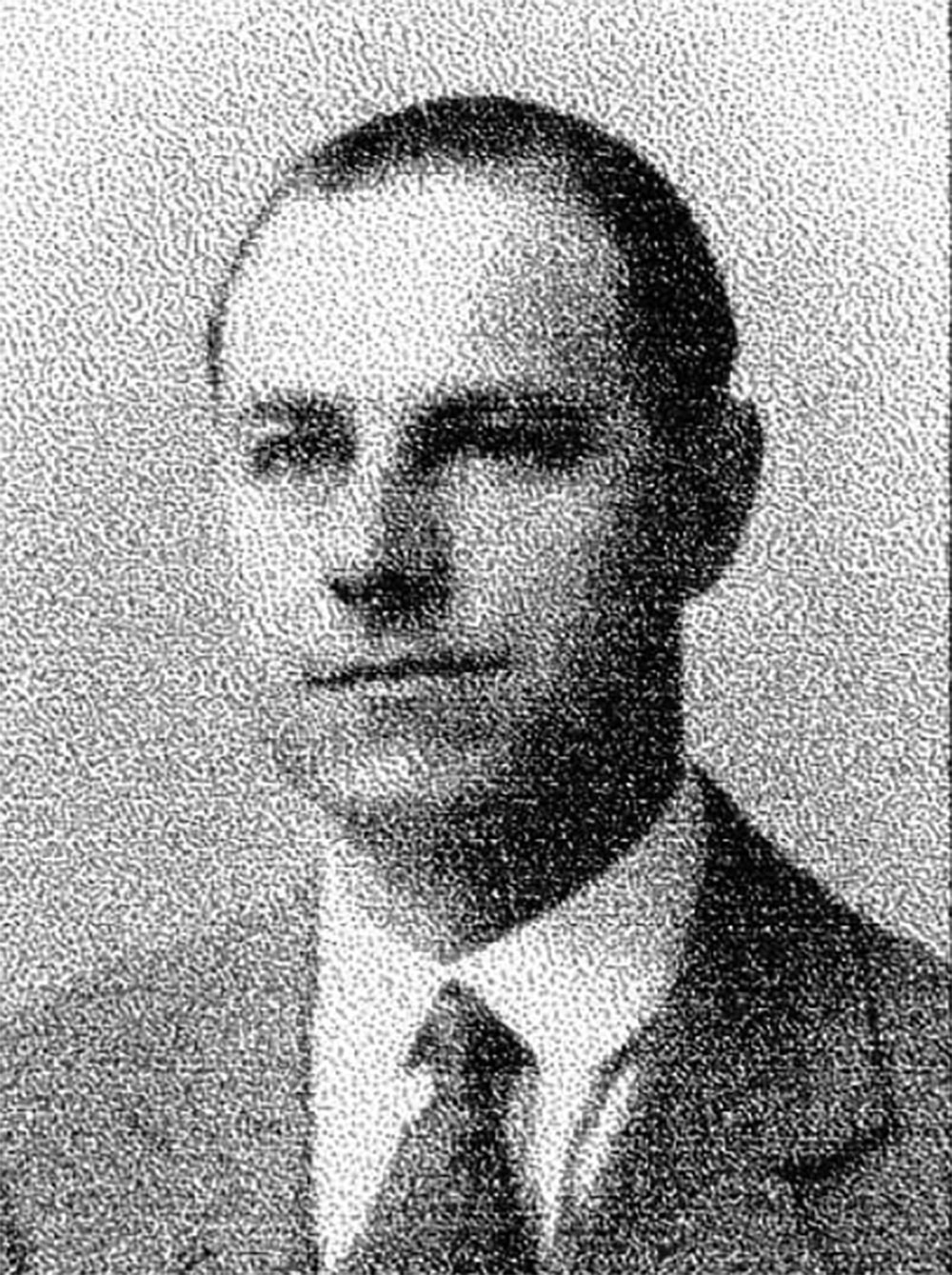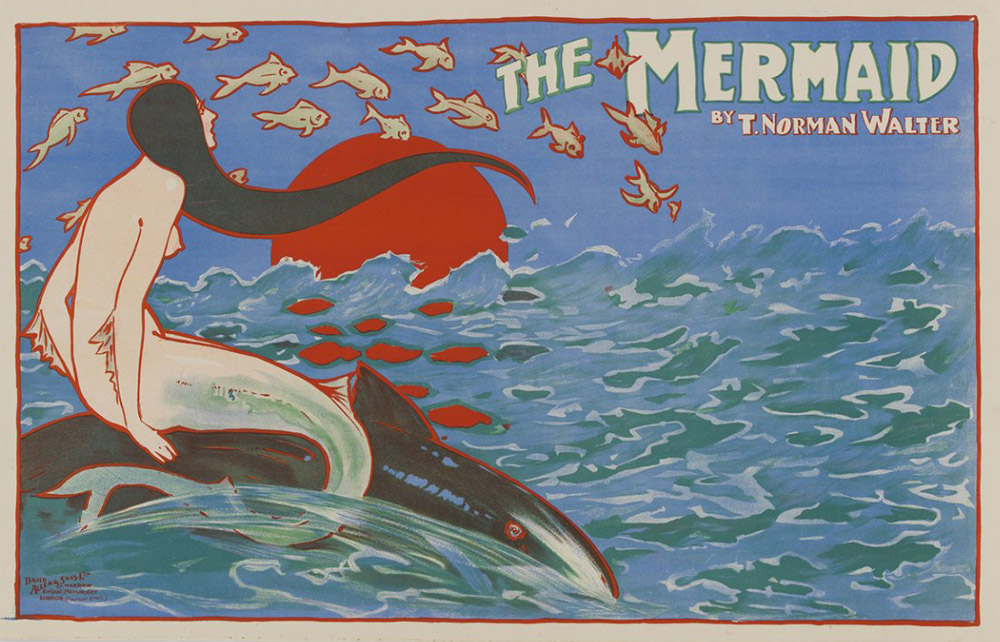Cedric Norman Walter, 1890 - 1973
by Brian Stevenson
last updated May, 2025
C.N. Walter was a skilled mounter of diatoms and a widely-recognized authority on the subject. He worked as an accountant in the London area. He was a member of the Quekett Microscopical Society and the Postal Microscopical Society, and a Fellow of the Royal Microscopical Society.

Figure 1.
Microscope slides by C.N. Walter, dated early-mid 1960s. He prepared slides of both selected/arranged and mixed strews of diatoms. Walter used custom-printed labels and off-the-shelf labels on which he wrote his name by hand. Adapted by permission from Jonathan Crowther (right) or for nonprofit, educational purposes from an internet auction site (left).

Figure 2.
Arrangement of 36 diatoms from Barbados, prepared in 1965 by C.N. Walter (see Figure 2). Adapted by permission from Jonathan Crowther.

Figure 3.
Undated photograph of Cedric Norman Walter. Adapted from ancestry.com.
Cedric Norman Walter was born on November 25, 1890, in Islington, Middlesex. He was the eldest of four children of Thomas Norman and Ellen Walter. Both parents were involved with theater, with the 1891 national census listing them as “actor” and “actress”, the 1901 census recording the father as a “theatrical stage worker”, and the 1911 census listing him as a “theater manager”. Figure 4 (below) is a poster for T. Norman Walter’s “The Mermaid”, an 1899 musical for which he wrote the dialogue and song lyrics.
The 1911 census also listed twenty year-old Cedric as working as a “chartered accountant’s clerk”, and living at home with his parents and two younger siblings.
Cedric married Violet Kingsford during the summer of 1914.
He enlisted in the Queen’s Own Royal West Kent Regiment on June 5, 1915. He served in combat during World War 1, suffering a gunshot wound to his right hand that resulted in the loss of two phalanges from his index finger. Cedric was mustered out of the Army on December 1, 1918, with the rank of Sergeant.
Back home in Lewisham, Cedric returned to accountancy. He was probably employed by Crichton J. Gladwell, of 95 Cannon Street, London, judging from the two men forming a partnership in 1920 as Gladwell, Walter and Company. They separated in 1928, with Cedric forming his own business as C.N. Walter and Company.
Around this time, the Walters settled at 32 Stanley Avenue, Beckenham, Kent, where they remained for the rest of Cedric’s life.
Cedric joined the Quekett Microscopical Club on June 26, 1956. He was also a member of the Postal Microscopical Society.
He later wrote in his Vade Mecum that he “did not commence serious mounting in any form until I started to retire, when I was 70” (ca. 1960).
Cedric Walter’s Vade Mecum, transcribed in 2014 by Steve Gill, provides interesting and helpful insights to his slide-making. It begins:
“In January 1963, I sent round a box with a little dissertation on, what is to me, ‘The Fascination of Diatoms’, and in my Foreword I said: ‘The Diatom slides I am sending round now are by other mounters, some by the masters, as a tribute to their work, the examination of which has given me many an enchanted hour. Now that I have a little more time, I have taken up the mounting of diatoms - but that is another story. I hope to tell you about ‘Operation Diatoms’ in a later contribution.
Well, my friends, here it is. This time you will not get the work of the Masters, or a Master, but only the humble effort of one who is trying, rather falteringly, to follow in their steps. Most of us like a Microscopical Gossip. It is always interesting to hear how the other chap does it, so you may not find uninteresting the following notes on my pilgrimage through this form of mounting. Perhaps it may encourage some others, who have not already done so, to take up this most fascinating game of making diatom preparations.
The mounting of diatoms certainly opened up to me a new and wonderful experience in the world of Microscopical Preparations as I soon discovered. At Belstead we had learnt how to make fluid mounts and dry mounts of other subjects and these principles could be applied in the case of diatoms; but to my idea, that is not the real art of diatom mounting. My ambitions went beyond that. The mounting of diatoms is not taught at Belstead, the reason being, as Mr. Marson explained, that so few people were interested, which is true.
So the question was how to find out the way the real mounting was done. Diatom mounters to-day are relatively few and far apart; there are none anywhere near me from whom I can get any practical and personal instruction, so I had to set forth to ‘furridge’ it out on my own from books or periodicals. I managed to get hold of the copies of two lectures which must have been given many years ago. One by E. Leonard, ‘A Paper read before the Liverpool Microscopical Society’; and the other by Sidney Chaffers, ‘A Paper read before the Manchester Microscopical Society’. There is no date on either but the indications are that in each case it must have been more than thirty years ago. Each consisted of 11 quarto pages close typed, and by the time I had read through these I felt like abandoning the whole idea, so meticulous and detailed was the procedure; however, I had accepted the challenge and was in honour bound to carry on.
My next step was to analyse each paper right out to get a complete programme and order; that in itself was quite a task; but it did do one thing, I began to get a grasp of the principles of making these preparations. Then I was fortunate. For just after that, in looking up a pre-war volume of "The Microscope" which I had borrowed to refer to something else, I came across the series of articles written by S.H. Meakin and C. Swatman. This was another complete and well detailed description of the art. It all seemed very complicated and did not seem to agree with the other two papers mentioned above. However, again I analysed all these articles in the same way, and when I came to compare the three I found that all worked on the same general principles and the differences were only those in detail and method. One finds this with other forms of mounting.
But one thing was outstanding in all of them and became thoroughly impressed on my mind, namely, the need for the strictest attention to every detail and above all cleanliness. In due course I found out why. One does not know the meaning of dust and dirt until you mount diatoms; or the need for filtering everything used of a liquid nature.
Of course, you can just put a bit of adhesive on a slide, put a diatom on it, some mountant on and a cover glass and say, ‘That's that, what is all the fuss?’ One might get a lucky one, mostly not, just a mount of a sort.
It was certainly not the way of the Masters. To my mind it is much more satisfying to carry it out thoroughly and try to produce a mount one can be proud of in every respect. I am afraid I agree with the perfectionists, of whom S.H. Meakin was one.
I decided to work more or less on the methods set out by S.H. Meakin; I had the proof of it in the many of his beautiful mounts which I possess, also he was nearer to to-day, (he only died in 1955) and the re-agents he mentions were more likely to be obtained to-day than some of those given by the earlier mounters.
I will not bore you with all the difficulties I met with and the many frustrations and failures through lack of any personal tuition, or the lack of the little tips that make all the difference; suffice it, that I gradually worked out a programme which I find produces results and it is the method very close to that of Meakin. .I am, indeed, very indebted to him, so skilled a mounter, for publishing his methods that others might benefit.
Meakin used one Microscope with a Mechanical Finger. I use two Microscopes for some mounts. You see, in the beginning, I did not have a mechanical finger and did not know where to obtain one, but I have a Watson Research Microscope which is binocular and stereoscopic. It is low power, maximum is x140. It has a fine large moveable stage, plenty of working room at all magnifications, and arm rests; it really is a lovely instrument and one which I have always enjoyed using for many purposes.
One, to me, little problem was how to get the diatom from the Search Slide, where they are all jumbled up together and dry, on to a mount slide in a particular position, and I wanted the two slides close together; so I made a small frame and fitted it on to the stage of the Research Microscope and thus held the two slides parallel to each other. I had three cat's whisker bristles of different thicknesses set in penholders, which were very useful for arranging delicate parts of insects and I found I could, by hand, pick up a diatom from the Search Slide with one of these and place it on the adjacent mounting slide - that is I could do so after some practice, it was not easy at first.
It was equally useful where a diatom is dirty and wants washing. Using one of Mr. Horrocks' hypodermic syringes, I can put a tiny drop of distilled water on a slide, pop the diatom into it, wash it and take it out again and place on the mount.
This hand method worked quite well if it was a single diatom which did not require positioning in a certain way, e.g. a Triceratium where one wants the base of the Triangle level with the edge of the slide. To do more than one diatom and get them into the right lay-out was a matter of luck although my hand is pretty steady - sometimes I succeeded and other times I did not. This was going to be a drawback.
I realised, however, it would be possible, by hand, to get two or three diatoms level provided I had a guiding line, and I cannot use a Graticule in the eyepieces of the Research. Then I made a discovery. I do not know whether other members know it but with the ordinary ninepenny Biro one can draw lines and circles on a glass slip provided it is grease free, and a mounting slide must be that. The Biro marks can be easily removed later with a little Rinso. So, by drawing on the under-side of the mounting slide a horizontal line across the centre of the slide and making a tiny ring on the ringing table in the centre of the line an excellent guide is provided, which is quite clearly seen through the slide under the Microscope. Provided the diatoms were not too close together I could now place them in a line. But this was going to be sufficient for more advanced preparations.
Then, one day, I saw an advertisement in ‘The Microscope’ by R.I. Firth of Lewes, of a Mechanical Finger. It was a lot of money but it was a copy of the one Meakin used, so I had it fitted to my Watson Service Microscope. I found it was not quite so simple, to me, as it sounds in Meakin's article and some time and practice were required. Such things as knocking the holder, or racking down the objective too much, or forgetting to raise the bristle when changing a slide. One day I broke the tip off the bristle and a nice old game it was trying to make another one out of celluloid like the original. A Cat's whisker did not seem to work successfully and for a time I did not get much use out of the Finger and did all I could by hand. Then a fellow member of the Quekett who, strangely enough, does not actually mount diatoms, recommended the use of Entomological Pins, and this ended my troubles and put the Mechanical Finger back into operation again. I use them now for hand work. These pins can be obtained with very fine points and variable thicknesses. The finest point can easily be slightly widened by very lightly drawing across a piece of wet-dry emery paper once or twice.
So I do most of my mounting by hand, except in the case of a group or where very fine adjustments are required, when I place them roughly in position by hand and finish them with the Mechanical Finger. The Mechanical Finger is all right if you can have the two slides side by side, and I believe the big mounters had special stages made for the purpose. The stage on the Service is not large enough for two slides, and to keep changing them each diatom not only takes extra time but considerably adds to the risk of damage as I have experienced.
As I have mentioned in previous note books, I keep a Microscopical Diary and in it I note, among other things, all my difficulties, and otherwise, while actually making the preparation, ending with comments on the final result. It contains complete details of each mount so that I can always refer back later and know exactly how it was prepared. I have a separate Diary for Diatoms and it is interesting now that I have made some progress to read over the notes and comments of the early struggles.
As I have said; I do not propose to bore you with the details of my various and so frequently disappointing diatom mounting experiences, but just to deal with, and illustrate by the mounts herewith, the various aspects of the art and the methods I have adopted. If anyone would like to have any further details, or to discuss any points I would be only too happy to send them, discuss them, if they like to write to me direct. I am always pleased to hear from a fellow member.
To my very great regret, I cannot say I clean any material, either fluid or fossil. I know how it is done but I have not ventured on it. The reason is that I feel I cannot take the risk, at my age, of handling the acids which are required. I might become over anxious and have an accident with them; so in these circumstances I bow to wisdom and leave it alone. Happily, I have been able to acquire from various sources a nice little stock of well cleaned material.”
The QMC members’ list appended the initials “F.R.M.S.” to Cedric’s name in the 1969 compilation, indicating that he had become a Fellow of the Royal Microscopical Society. Both Cedric and Violet were members of the London Natural History Society. Cedric resigned from the QMC at the end of 1971.
The Postal Microscopical Society received a special collection, “donated in 1971 by C.N. Walter, consisting of all his notebooks and most of the slides which accompanied them”.
Cedric Norman died on October 27, 1973.

Figure 4.
An 1899 advertising poster for “The Mermaid”, a musical comedy/drama that was written by C.N. Walter’s father. Adapted for nonprofit, educational purposes from https://www.mahmah.ch/collection/oeuvres/mermaid-t-norman-walter/e-2017-0693
Acknowledgements
Many thanks to Jonathan Crowther for generously sharing images of a C.N. Walter microscope slide from diatomimaging.com.
Resources
The Accountant (1928) “Messrs. Gladwell, Walter & Co., Incorporated Accountants, announce that the partnership formerly subsisting between Mr. Crichton James Gladwell and Mr. Cedric Norman Walter has been dissolved by mutual consent as from the 30th September 1928. Mr. Gladwell will continue to practise as C.J. Gladwell & Co. at Finsbury Pavement House, E.C.2, and Mr. Walter will practise at the same address under the title of C.N. Walter & Co.”, Vol. 79, page 469
Bracegirdle, Brian (1998) Microscopical Mounts and Mounters, Quekett Microscopical Club, London, pages 97 and 178, Plate 37-F
England censuses and other records, accessed through ancestry.com
The Era Almanack (1899) “The Mermaid, musical comedy-drama, in three acts, by T. Norman Walter; music by Reuben W. Manning, lyrics by T. Norman Walter; Grand Theatre, Chorley, December 26”, page 73
Gill, Steve (2014) A Diatomist’s Vade Mecum, accessed May, 2025 from http://www.microscopy-uk.org.uk/diatomist/cnwalter.pdf
Incorporated Accountants' Journal (1920) “Mr. C. J. Gladwell, Incorporated Accountant, has taken into partnership Mr. Cedric Norman Walter, Incorporated Accountant. The style of the firm will in future be Gladwell, Walter & Co., with offices at 95, Cannon Street, London, E.C.”, Vol. 31, page 211
Journal of the Quekett Microscopical Club (1962) QMC Membership list
The London Naturalist (1959) Members of the London Natural History Society
Microscopy, The Journal of the Quekett Microscopical Club (1969) QMC Membership list
Samworth, Mike (2009) Diatom visibility index and the slides of C.N. Walter, The Amateur Diatomist, Vol. 4, pages 39-41
Sessions, R.H. (1973) A century of postal microscopy: The history of the Postal Microscopical Society, Microscopy, the Journal of the Quekett Microscopical Club, Vol. 32, pages 225-238



